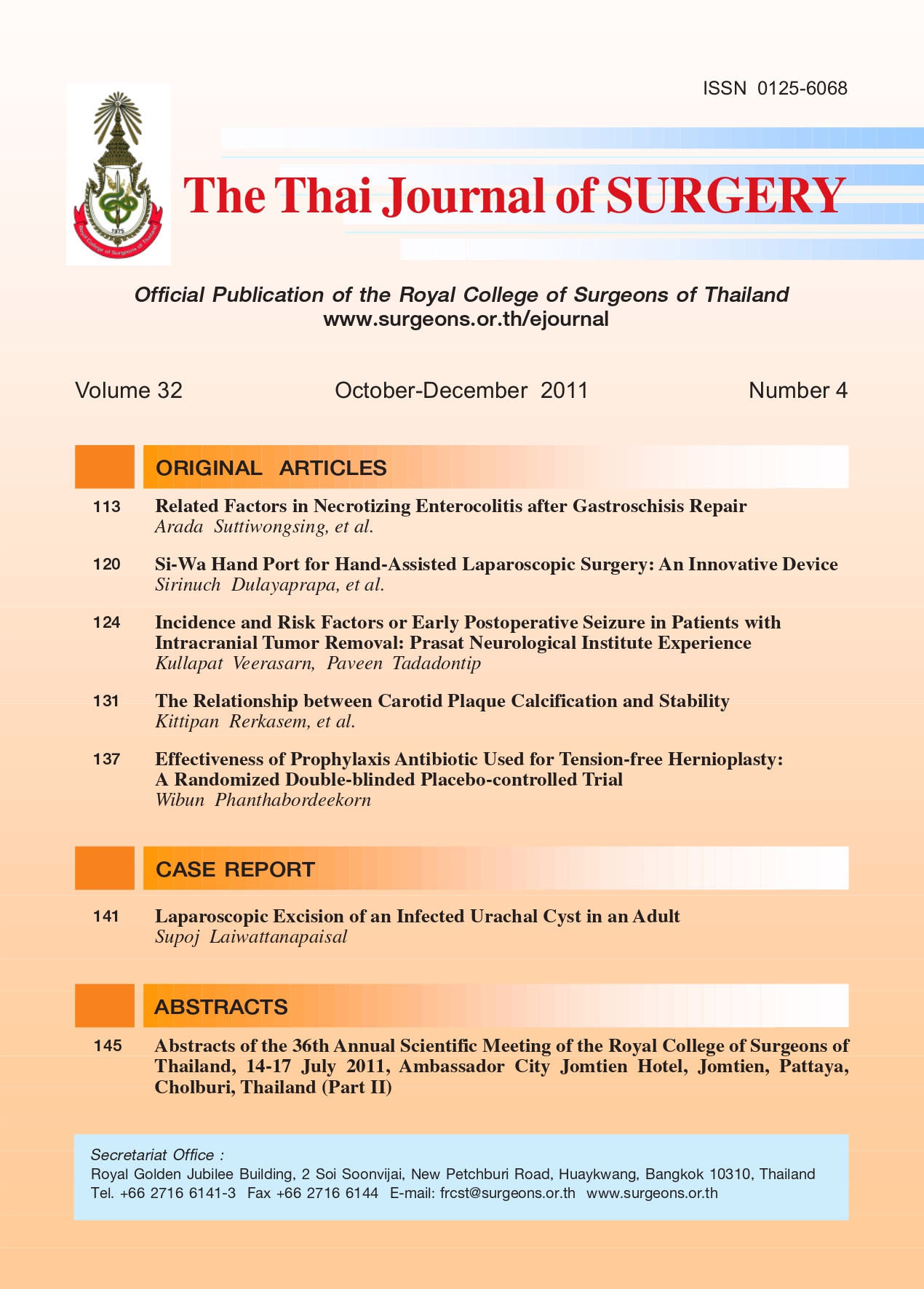Monitoring Interstitial Glucose Changes During Ischemia/Reperfusion in Human Cutaneous Free Flaps
Keywords:
free flap, monitoring, interstitial glucose, ischemia/reperfusionAbstract
Background: Free tissue transfer has unique post ischemic tissue metabolism that resembles theischemia/reperfusion model. Glucose regulation during ischemia/reperfusion and effects of the insult to
glucose metabolism in various human skin flaps were examined in this study by using the continuous glucose
monitoring device.
Methods: Seven cutaneous-containing free flaps reconstruction were performed in seven adult patients.
Interstitial glucose within the flaps was monitored using a transcutaneous sensor. Interstitial glucose (ISG) was
recorded from flap harvesting until one hour following arterial anastomosis. Interstitial glucose concentrations
and trends were reported.
Results: Six free flaps were successfully monitored according to study protocol. The initial mean ISG in
the flap was 111.219± 26.33 (59.5-129) mg/dl. The glucose average rate of fall was 1.04 mg/min after pedicle
transection. Average time to reach low plateau phase (47.49± 13.98% of initial ISG) was 87± 42.16 minutes. The
mean ischemic time was 165.83± 53.88 (105-237) minutes. After arterial reperfusion, the interstitial glucose rose
in the average rate of 0.79 mg/min. The 1-hr post-reperfusion ISG remained stable at 87.5± 6.85% (75.51-94.1)
of the initial (p = 0.01). Weak negative correlation between ischemic time and 1-hr post-reperfusion ISG was
observed (r = -0.59).
Conclusions: Interstitial glucose concentration in human skin flap during ischemia/reperfusion episode
is correlated with tissue perfusion. Prolonged ischemia compromises glucose metabolism in the early reperfusion
period.
Keywords:
References
oxygenation and perfusion by near-infrared reflection
spectroscopy and color-coded duplex sonography. Plastic
Reconstructive Surg 2004;113:141-52.
2. Siemionow M, Arslan E. Ischemia/reperfusion injury: a review
in relation to free tissue transfers. Microsurgery. Wiley Online
Library 2004;24:468-75.
3. Wang WZ, Baynosa RC, Zamboni WA. Update on ischemiareperfusion
injury for the plastic surgeon: 2011. Plast Reconstr
Surg 2011;128:685e-92e.
4. Wang W. Investigation of reperfusion injury and ischemic
preconditioning in microsurgery. Microsurgery 2009;29:72-9.
5. Eisenhardt SU, Schmidt Y, Karaxha G, Iblher N, Penna V,
Torio-Padron N, et al. Monitoring Molecular Changes
Induced by Ischemia/Reperfusion in Human Free Muscle
Flap Tissue Samples. Ann Plast Surg 2012;68:202-8.
6. Edsander-nord Å, Ph D, Röjdmark J, Wickman M.
Experimental Metabolism in Pedicled and Free TRAM Flaps:
a Comparison Using the Microdialysis Technique. Plast
Reconstr Surg 2001;664-73.
7. Gebhard MM, Germann G. Experimental Ischemic
Preconditioning by Brief Extremity Ischemia before Flap
Ischemia in a Rat Model. Plast Reconstr Surg. 2001;2398-404.
8. Küntscher M V, Hartmann B, Germann G. Remote ischemic
preconditioning of flaps: a review. Microsurgery 2005;25:346-
52.
9. Coskunfirat OK, Ozkan O, Dikici MB. The effect of ischemic
preconditioning on secondary ischemia in skin flaps. Ann
Plast Surg 2006;57:431-4.
10. Moon JG, Lim HC, Gye MR, Oh JS, Park JW. Postconditioning
attenuates ischemia-reperfusion injury in rat skin flap.
Microsurgery 2008;28:531-7.
11. Kraemer R, Lorenzen J, Kabbani M, Herold C, Busche M,
Vogt PM, et al. Acute effects of remote ischemic
preconditioning on cutaneous microcirculation - a controlled
prospective cohort study. BMC Surg 2011;11:32.
12. Minh TC, Ichioka S, Nakatsuka T, Kawai J, Shibata M, Ando
J, et al. Effect of hyperthermic preconditioning on the
survival of ischemia-reperfused skin flaps: a new skin-flap
model in the mouse. J Reconstr Microsurg 2002;18:115-9.
13. Izquierdo R, Swartz WM, Sutker KB, Boydell CL, Almand J.
Attenuation of Reperfusion-induced Lipoperoxidation by
Systemic Use of Oxygen Radical Scavengers after Pedicle
Occlusion. Ann Plast Surg 1992;28:175.
14. Cordeiro PG, Lee JJ, Mastorakos D, Hu QY, Pinto JT,
Santamaria E. Prevention of ischemia-reperfusion injury in a
rat skin flap model: the role of mast cells, cromolyn sodium,
and histamine receptor blockade. Plast Reconstr Surg
2000;105:654-9.
15. Jyränki J, Suominen S, Vuola J, Bäck L. Microdialysis in clinical
practice: monitoring intraoral free flaps. Ann Plast Surg
2006;56:387-93.
16. Smit JM, Zeebregts CJ, Acosta R, Werker PMN.
Advancements in free flap monitoring in the last decade: a
critical review. Plast Reconstr Surg 2010;125:177-85.
17. Sitzman TJ, Hanson SE, King TW, Gutowski K a. Detection of
flap venous and arterial occlusion using interstitial glucose
monitoring in a rodent model. Plast Reconstr Surg
2010;126:71-9.
18. Vrancic C, Fomichova A, Gretz N, Herrmann C, Neudecker
S, Pucci A, et al. Continuous glucose monitoring by means
of mid-infrared transmission laser spectroscopy in vitro.
The Analyst 2011;136:1192-8.
19. Schoonen AJM, Wientjes KJC. A model for transport of
glucose in adipose tissue to a microdialysis probe. Diabetes
Technol Ther 2003;5:589-98.
20. Cengiz E, Tamborlane WV. A tale of two compartments:
interstitial versus blood glucose monitoring. Diabetes
Technol Ther 2009;11 Suppl 1:S11-6.
21. Battelino T, Bolinder J. Clinical use of real-time continuous
glucose monitoring. Curr Diabetes Rev 2008;4:218-22.
22. Hoopes J, Im M. Skin flap necrosis in guinea pigs limitation of
glucose supply and accumulation of lactate. Plast
Reconstr Surg 1978.
23. Im M, Su C, Hoopes J. Skin-flap metabolism in rats: Oxygen
consumption and lactate production. Plast Reconstr Surg
1983.
24. Blomqvist L, Malm M. Metabolism in myocutaneous flaps
studied by in situ microdialysis. J Plast Surg 1998;2:27-34.
25. Setäalä LP, Korvenoja EM-L, Härmä M a, Alhava EM, Uusaro
A V, Tenhunen JJ. Glucose, lactate, and pyruvate response
in an experimental model of microvascular flap ischemia
and reperfusion: a microdialysis study. Microsurgery
2004;24:223-31.
26. Laure B, Sury F, Bayol J-C, Goga D. Microdialysis: experience
in postoperative monitoring of 30 free flaps. Ann de Chirurgie
Plastique et Esthétique 2009;54:29-36.
27. Carroll WR, Esclamado RM. Ischemia/reperfusion injury in
microvascular surgery. Head Neck 2000;22:700-13.
28. Stephenson LL, Zamboni WA. Experimental timing of
microcirculatory injury from ischemia reperfusion. 2000;785-
8.
29. Fitzal F, Valentini D, Mittermayr R, Worseg a, Gasser IH, Redl
H. Circulatory changes after prolonged ischemia in the
epigastric flap. J Reconstr Microsurg 2001;17:535-43.
Downloads
Published
How to Cite
Issue
Section
License
Articles must be contributed solely to The Thai Journal of Surgery and when published become the property of the Royal College of Surgeons of Thailand. The Royal College of Surgeons of Thailand reserves copyright on all published materials and such materials may not be reproduced in any form without the written permission.


